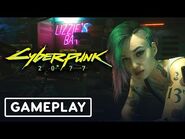Everything on full blast. They'll spot us extra for a wicked adrenaline high.
— Unnamed thug, Cyberpunk 2077
A braindance, commonly abbreviated to BD, is a technology that allows to record and play back someone's experience, including their physical sensations, emotions, and thoughts. Braindances were invented by Yuriko Sujimoto in 2007, and were heavily used in psychological treatment. Braindances came to be used more commonly for entertainment, and enjoy wide use in the Cyberpunk universe. Various devices have been developed in order to record, edit, and play back braindances, from recorders to viewers to wreaths.
Braindance in 2020[]
After the academic experiments that led Sujimoto to invent braindance technology, BD was repurposed for criminal reconditioning and for military simulations with funding from the State of California and Militech. By 2009, Sujimoto and a penal psychologist called Lassimer founded Braindance Incorporated with government contracts. Soon after, a joint venture between Militech, Braindance Inc., and Diverse Media System (DMS) released an entertainment form of braindance. Public demand for braindance media grew rapidly, and DMS quickly cornered the market by developing "the world's premier editing facilities and the most extensive braindance chip distribution network". Braindance Inc. and Militech continued to be other key manufacturers of braindance chips.[1]
Braindance in 2077[]
For many Night City residents, crushing poverty and homelessness are significant and likely inescapable problems. Despite this, most are still entranced by the glitz of showbiz and luxurious lifestyles of the privileged elite. Breakthroughs in neural technology such as BD have paved the way for people to share recordings of their own emotions and personal memories. Other BD productions put actors in staged situations to create false memories. BDs that are simple recordings of a day in the life of the world's biggest and brightest stars are also popular. The ability to "become" a celeb and experience a life of luxury gives many a chance to escape their own miserable reality. As a result, braindance addiction has become an ever-growing problem for the city's poor.[2]
Unedited BD recordings are called virtus in The Street. Unlike commercial BDs, the sensory input and emotions in a virtu are raw and unedited, essentially the real sensations and feelings that were recorded. It is common to record and sell virtus to BD editors so they can scroll these recordings for additional profit.
Illegal Braindance[]
Illicit BD recordings, also called Extreme Braindances (XBDs), feature gruesome and bizarre scenes, including violence, torture, and even rape and murder. XBDs are created by small teams who kidnap unwilling victims. Some XBDs are recorded from the perspective of the torturer. Other XBDs are from the perspective of the torturee: the virtus of these are often taken from the corpses of the victims. There is a market for both.
XBDs can be found easily in the seedy underbelly of Night City's black market, although sold through secretive dealers.[2]
Database Entries (2077)[]
BRAINDANCE
As braindance's popularity spread, public opinion divided into two camps: those who saw the new technology as a revalation, and those who saw it as a threat. Some predicted braindance would save humanity as we know it, bringing an end to unecessary conflict and ushering us into a new utopian age of mutual understanding and respect. After all, the argument went, if you look at yourself from your enemy's point of view, if you understand him deeply – and vice versa – he ceases to be your enemy.
Others, however, foresaw a wave of new addictions, deepening isolation and societal division, even a crisis of identity.
In the end, the market proved both views right – braindance became an everyday product, another form of entertainment, but also a new form of surveillance.
In essence, braindance is the transfer of the conscious experiences of the person who recorded (or "scrolled") them to one who "relives" them. The raw material must first be processed, or edited, before it can be used.[2]
ILLEGAL BRAINDANCE
Illegal braindances, or XBDs, appeared on the black market almost as soon as braindance recording technology became publicly available. Rare fetishes, violence, sadomasochistic fantasies and even death are the most common motifs in XBDs.
These braindances are scrolled in secret, usually by force, and are rarely edited. Reliving such recordings can cause nausea, epileptic seizures or, in extreme cases, even death.
XBDs have their own regular group of viewers. Demand for the scrolls remains as high as ever, meaning new producers are continually arriving on the scene. Some have even managed to form their own well-known brands and continue to push the limits of what's possible – albeit morally reprehensible.[2]List of braindances[]
Associated Quests (2077)[]
Main Jobs[]
Side Jobs[]
- Imagine
- Stairway To Heaven
- Poem Of The Atoms
- Meetings Along The Edge
- I Fought the Law
- The Hunt
- Over the Edge
- Sweet Dreams
- Gig: Dirty Biz
- Gig: Monster Hunt
Associated Shards (2077)[]
Gallery[]
Videos[]
References[]
- ↑ FISK, C. Rockerboy Sourcebook. Berkeley, CA, R. Talsorian Games, 1989. (pp.49,63)
- ↑ 2.0 2.1 2.2 2.3 CD Projekt RED. Cyberpunk 2077. Video Game, Multi-Platform. Poland, CD Projekt S.A., 2020.




